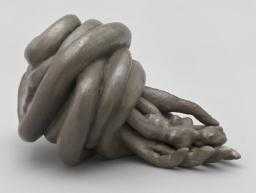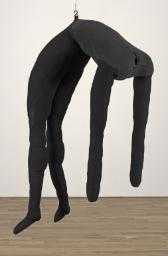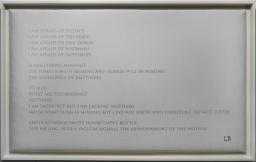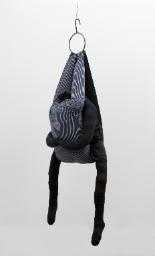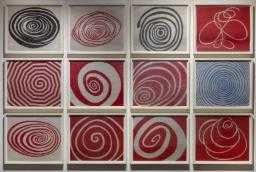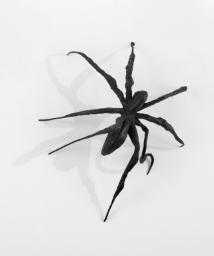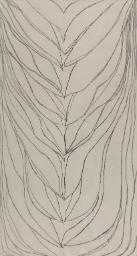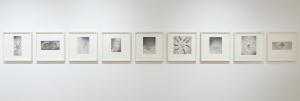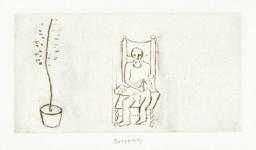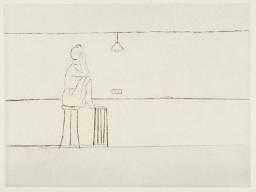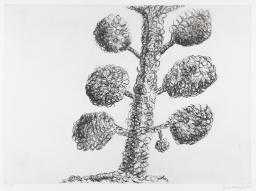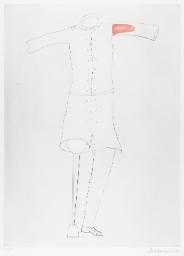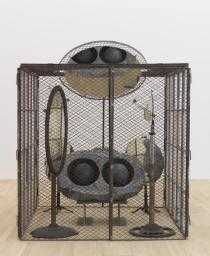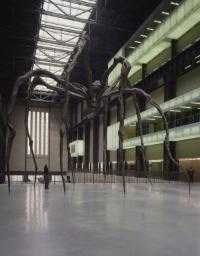
Not on display
- Artist
- Louise Bourgeois 1911–2010
- Medium
- Steel, glass, wood, metal and red fabric
- Dimensions
- Object: 1880 × 1219 × 1219 mm, 280 kg
- Collection
- ARTIST ROOMS
Tate and National Galleries of Scotland. Lent by Artist Rooms Foundation 2011
On long term loan - Reference
- AL00230
Summary
Cell XIV (Portrait) is a multipart work consisting of a cage-like structure containing a red fabric sculpture of three faces that sit on top of a metal table. The three faces are stitched together and share a pedestal. The table sits slightly off-centre on the wooden base of the structure. The structure itself is a steel frame with panels of steel mesh and glass on three sides, with steel mesh on the remaining side and on its top. The wooden base that forms the bottom of the structure sits within the steel frame on four legs, meaning that the base is raised off the floor.
The ‘Cell’ structure is one that has appeared frequently in Bourgeois’s work from the late 1980s onwards. These installations are often constructed using salvaged architectural objects such as doors, windows, panes of glass, wood and, in the case of both Cell XIV (Portrait) and Cell (Eyes and Mirrors) 1989–1993 (Tate T06899), steel mesh around a steel frame. Bourgeois deliberately used the term ‘cell’ when describing these multipart works due to the diverse ways in which the word could be interpreted. In an interview in 1991 Bourgeois said:
‘Cellule’ Communiste, ‘cellule’ in a prison, and very, very especially, the ‘cellule’ of our blood. That is to say, little entities that are next to each other and are different from each other. Sometimes they repulse each other … So this is a cell. This is absolutely separate. So they are right next to each other like this, and they will not touch or talk to each other for a hundred years.
(Quoted in Morris 2007, p.71.)
The multiple readings of the term ‘cell’ are echoed in the ambiguous nature of the relationship between the structure of the cell, its contents and the viewer. The three heads of the central sculpture pull in different directions, perhaps representing the potential for conflicting thoughts and emotions within society as well as within oneself. Curator Lucy Askew has argued that the visible stitching on the heads represent both physical and emotional scars (Askew and d’Offay 2013, p.88). The contrast between the soft red fabric, stitched together to form the central sculpture, is in stark contrast with the cold, hard steel that forms the surround, thus highlighting the literal and figurative vulnerability of the three heads. Their mouths appear to gape, giving the impression that they are crying out in pain, anger or fear. These are recurring themes in each of Bourgeois’s ‘cell’ works. The artist described the role of fear and pain in the ‘cells’ in 1991:
The Cells represent different types of pain: the physical, the emotional and psychological, and the mental and intellectual. When does the emotional become the physical? When does the physical become the emotional? It’s a circle going round and round. Pain can begin at any point and turn in either direction. Each Cell deals with fear. Fear is pain. Often it is not perceived as pain, because it is always disguising itself. Each cell deals with the pleasure of the voyeur, the thrill of looking and being looked at. The Cells either attract or repulse each other. There is this urge to integrate, merge or disintegrate.
(Quoted in Marie-Laure Bernadac and Hans-Ulrich Obrist (eds.), Louise Bourgeois: Destruction of the Father, Reconstruction of the Father: Writings and Interviews 1923–1997, London 1998, p.205.)
Art historian Alex Potts has also argued that viewing the ‘cells’ is a voyeuristic experience, given that the viewer is kept at a distance from the central sculpture while still being able to observe it through opaque glass or steel mesh (Morris 2007, p.264).
Further reading
Mignon Nixon, Fantastic Reality: Louise Bourgeois and a Story of Modern Art, London and Cambridge, Massachusetts 2005.
Francis Morris (ed.), Louise Bourgeois, exhibition catalogue, Tate Modern, London 2007, pp.71, 264.
Lucy Askew and Anthony d’Offay, Louise Bourgeois: A Woman Without Secrets, exhibition catalogue, National Galleries of Scotland, Edinburgh 2013, p.88, reproduced pp.16, 53.
Allan Madden
The University of Edinburgh
October 2015
The University of Edinburgh is a research partner of ARTIST ROOMS.
Does this text contain inaccurate information or language that you feel we should improve or change? We would like to hear from you.
Display caption
For Bourgeois, the three-headed state is one of confusion, ambivalence and hysteria – as if the figure were being torn in different directions. Three was a significant number for Bourgeois as she was the middle child in a family of three and she herself had three children.
Gallery label, October 2016
Does this text contain inaccurate information or language that you feel we should improve or change? We would like to hear from you.
Explore
- abstraction(8,615)
-
- from recognisable sources(3,634)
- residential(5,553)
-
- cell(4)
- emotions and human qualities(5,345)
- enclosure(72)
- furnishings(3,081)
-
- table(754)
- cage(54)
- actions: expressive(2,622)
-
- screaming(30)
- head / face(2,497)
- classical myths: creatures(143)
-
- Cerberus(3)
- crime and punishment(436)
-
- imprisonment(25)
You might like
-
Louise Bourgeois Nature Study
1986 -
Louise Bourgeois Single II
1996 -
Louise Bourgeois I Am Afraid
2009 -
Louise Bourgeois Couple I
1996 -
Louise Bourgeois Spirals
2005 -
Louise Bourgeois Spider I
1995 -
Louise Bourgeois The Smell of Eucalyptus (#2)
2006 -
Louise Bourgeois Ode à Ma Mère
1995 -
Louise Bourgeois Paternity
1994 -
Louise Bourgeois Empty Nest
1994 -
Louise Bourgeois Tree
1998 -
Louise Bourgeois Amputee with Peg Leg
1998 -
Louise Bourgeois Cell (Eyes and Mirrors)
1989–93 -
Louise Bourgeois Mamelles
1991, cast 2001 -
Louise Bourgeois Maman
1999

